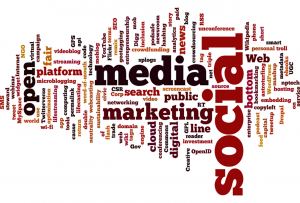As Cookies Crumble, Publishers Come Out to Play

Introduction:
In January 2020, Google announced that web browser Chrome would be dropping third-party cookies by 2022. According to Google, blocking third-party cookies is meant to “enhance privacy” for end-users and “to support publishers.”[1]So, with the end of third-party cookies, newsroom publishers (among other digital publishers) will see a switch in revenue streams and how they build digital ad sales. With Chrome making two-thirds of browser market share, digital publishers and digital newsroom are slated for substantial change in the coming months.
Third-Party Cookies

For this post—it seemed fitting—to use the definitions of Google Chrome Help to explain third-party cookies. “Cookies are files created by websites you visit…Third-party cookies are created by other sites. These sites own some of the content, like ads or images, that you see on the webpage you visit.”[2]The majority of data collected by third-party cookies are used for targeted advertising.
As third-party data disappears, advertisers will look to publishers” – Kristy Schafer, VP Americas – Permutive
To Exist Digitally

Publishers, such as newsroom publishers, use online ads in order to create revenue. Digital ads serve as a way for newsrooms to monetize on their work as more users are reading news digitally. Small newsroom publishers greatly benefit from third parties to sell ads. “Publisher webpage include…more opportunities for…advertisements from third-party advertisers (…space for a banner advertisement…spaces for advertisements along the sides…overlays).”[3] In the old-era (pre-internet) print was the favored medium for users to collect and consume content, and print advertisement carried the newsroom. Today, digital advertisement is the leading force and focus of revenue streams for newsrooms.
Three’s a Crowd
With digital news outlets gating content, creating paywalls, and depending more on digital to drive growth and revenue, third-party cookies provided easy access to user-data and a selling platform for a lean newsroom of journalists and editors entering the digital sphere.

“Publishers…rely on third-party cookies from ad networks and others that can infer their audience makeup and pool them with other publishers to meet advertisers’ demand for scale.”[4]Big and small digital newsrooms still developing digital market and analytics teams, rely on third-party advertisers that use cookies to collect and process their readers data, which then informs how the publisher ad slots sell on the open ad exchange. In a way, open ad exchange allows publishers to leverage what they do know (their content and brand) while outside advertisers focus on user-data which they collect after placing one ad on their site and enabling cookies. “An ad exchange…operates as an intermediary…When a user visits a Web page…the publisher may post an ad slot in the exchange…then, an auction is run to determine the winner and the ad to be shown.”[5]Until recent, even major publishers like the New York Times sold ad slots via open ad exchange.
Beginning of the End
“Every new publisher should see this new world as an opportunity, in which they are the primary, and indeed only online advertising data supplier” – Kristy Schafer, VP Americas – Permutive
With the end of third-party cookies, also comes an end to the current way in which publishers and advertisers conduct business. “The third-party cookie served as the workhorse of the independent ad tech ecosystem…the real time bidding ‘ecosystem doesn’t work without a third-party cookie.’”[6]After 2022, buying ad slots on publisher’s platforms via open ad-exchange would yield no return on data for advertisers and will be a harder sell for small publishers with open ad slots. “The removal of third-party cookies…hurt the ability of publishers on the open web to monetize their content (as very few, if any, of them have large addressable first-party audience at scale).”[7]For advertisers, the end of third-party cookies means the end of tracking user behavior, ability to retarget, and then tracking conversion, of a publisher’s user. The two-way economy between publishers and digital advertisers, ends.

Time to Party
According to Google, the end of this revenue stream reliant on the data from third-party cookies, will benefit digital publishers. “Publishers believe this demand for alternatives to third-party cookies will kickstart their sputtering ad businesses…Google’s decision forces advertisers to cozy up to publishers—and rely more on their own customer information.”[8]
When Chrome drops third-party cookies, publishers will now be the most knowledgeable in regard to who is their readership, their demographics, their interests and behaviors. Digital publishers (such as newsrooms) who have always produced content to spread information and share stories, whose goal is reach readers and consumers of media, will now have leverage in an increasingly small and competitive market. The first-party cookies that will now be collected by publishers when users visit their domain, will be the coveted data that will drive digital advertising. “The likes of Time Out, Immediate Media and MailOnline are in a better position to thrive…because these publishers possess their own information on their audiences.”[9]
Ahead of the Party Pack

According to Jane B. Singer in her essay, “Five Ws and an H: Digital Challenges in Newspaper Newsrooms and Boardrooms” the economic digital market (as is currently) has to change for journalistic content to survive in the digital realm. “The fundamental issue for the future of newspapers, or journalism…is whether the Internet can create a new economic model.”[10]The New York Times, think that the end of third-party cookies is the new economic model digital newsrooms have been hoping for.
“The Times has never necessarily been the very best place for bottom-of-the-funnel, direct-response ads. The space we have to play in is helping [brands] build a relationship with the audience they care most about” – SVP of Ad innovation at New York Times – Allison Murphy
This year, at the height of Google announcing Chrome would be dropping third-party cookies, the New York Times began its own re-structuring. A major move for the publisher—as it prepares for a cookie-less world—was the elimination of open ad exchange for selling digital ad slots. “In the past year, the Times eliminated open programmatic…the clock is ticking on how long that option for buying and selling ads has left as the third-party cookie approaches its end date.”[11]According to Senior Vice-President of ad innovation Allison Murphy, The Times “is going to focus on offering first-party alternative solutions…the ads that come through the open exchange are typically not best suited for the publisher anyway.”[12]
Kings and Queens of the Party
With strong subscription-based readership, The Times is going to focus on the data from their subscribers (first-party data), and work with digital advertisers to find ads better-suited and aligned with their readership. Although 2022, is some time away, I believe digital newsrooms will probably follow suit and begin finding ways to monetize on their digital readership and first-party data.
As publishers adapt to the oncoming changes, first-party data will become the new online currency and publishers will thrive through their content and the direct relationship built with their readership. Revenue for these digital newsrooms and publishers will no longer come from advertisers seeking to target a certain user but rather, from advertisers seeking to appear within a particular context.
References:
- Massey, Kyle. “Cutting Out the Cookies From Web Advertising.” Arkansas Business, vol. 37, no. 9, 2 Mar. 2020, p. 20. Gale General OneFile, https://link-gale com.proxy.uba.uva.nl:2443/apps/doc/A618690029/ITOF?u=amst&sid=ITOF&xid=0b96ad53. Accessed24 Sept. 2020.
- https://support.google.com/chrome/answer/95647?co=GENIE.Platform%3DDesktop&hl=en
- “Patent Issued for Setting First-Party Cookies By Redirection (USPTO 10,764,350).” Marketing Weekly News, 19 Sept. 2020, p. 273. Gale OneFile: News, https://link-gale-com.proxy.uba.uva.nl:2443/apps/doc/A635298796/STND?u=amst&sid=STND&xid=4524f278. Accessed 24 Sept. 2020.
- Peterson, Tim. “Could a post-cookie world benefit publishers?” ADWEEK, vol. 54, no. 15, 15 Apr. 2013, p. 10+. Gale Academic OneFile, https://linkgalecom.proxy.uba.uva.nl:2443/apps/doc/A327356718/AONE?u=amst&sid=AONE&xid=5944209a. Accessed 24 Sept. 2020.
- Balseiro, Santiago R., et al. “Repeated auctions with budgets in ad exchanges: approximations and design.” Management Science, vol. 61, no. 4, 2015, p. 864+. Gale Academic OneFile, https://link-gale-com.proxy.uba.uva.nl:2443/apps/doc/A424105538/AONE?u=amst&sid=AONE&xid=1eec1389. Accessed 27 Sept. 2020.
- Joseph, Seb. “Winners, Losers and Fallout from Google’s Plan to Drop Cookies.” Digiday, 16 Jan. 2020, digiday.com/marketing/winners-losers-fallout-googles-plan-drop-cookies/.
- Geradin, Damien and Katsifis, Dimitrios, Taking a Dive Into Google’s Chrome Cookie Ban (February 19, 2020). Available at SSRN: https://ssrn.com/abstract=3541170 or http://dx.doi.org/10.2139/ssrn.3541170
- Joseph, Seb. “Winners, Losers and Fallout from Google’s Plan to Drop Cookies.” Digiday, 16 Jan. 2020, digiday.com/marketing/winners-losers-fallout-googles-plan-drop-cookies/.
- Joseph, Seb. “Winners, Losers and Fallout from Google’s Plan to Drop Cookies.” Digiday, 16 Jan. 2020, digiday.com/marketing/winners-losers-fallout-googles-plan-drop-cookies/.
- Singer, JaneB. “Five Ws and an H: Digital Challenges in Newspaper Newsrooms and Boardrooms.” JMM: The International Journal on Media Management, vol. 10, no. 3, July 2008, pp. 122–129. EBSCOhost, doi:10.1080/14241270802262468.
- Barber, Kayleigh. “’Ripped the Band-Aid on Some Hard Decisions’: How The New York Times Is Reshaping Its Ad Business for a Cookie-Less World.” Digiday, 25 Sept. 2020, digiday.com/media/ripped-the-band-aid-on-some-hard-decisions-how-the-new-york-times-is-reshaping-its-ad-business-for-a-cookie-less-world/.
- ]Barber, Kayleigh. “’Ripped the Band-Aid on Some Hard Decisions’: How The New York Times Is Reshaping Its Ad Business for a Cookie-Less World.” Digiday, 25 Sept. 2020, digiday.com/media/ripped-the-band-aid-on-some-hard-decisions-how-the-new-york-times-is-reshaping-its-ad-business-for-a-cookie-less-world/.